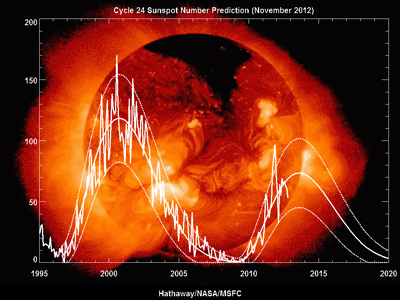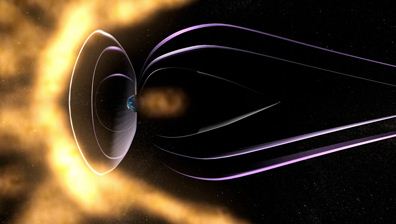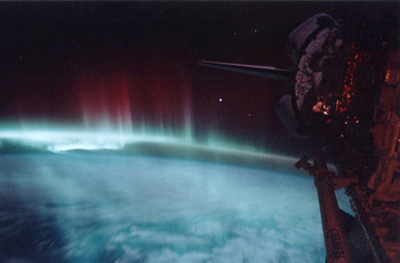Doomsday 2012: Here Comes the Sun
Solar storms are another common concern for those worried about Doomsday in December of 2012. But what are the real dangers from the Sun?
The Sun is a star, a giant ball so hot that it is in a gaseous ionized state and glows brightly. We figure that the Sun has been calmly generating energy by fusing hydrogen into helium for nearly 4.6 billion years and will go on doing so for probably another 4.5 billion years. Nearly all of the energy we use on Earth comes from the light of the Sun, steadily shining on us. Life on Earth would not exist if it weren’t for the Sun. Sure, the ultraviolet, X-ray and gamma ray light from the Sun is dangerous in large doses; but luckily our atmosphere does a good job of blocking nearly all of the most dangerous radiation.

A composite image of data from the Space Dynamics Observatory showing the Sun’s photosphere (white), chromosphere (red), corona (green), and higher energy corona (blue).
Solar Storms
The Sun does have its moody side, however. The magnetic field of the Sun is very strong and dynamic. Parts of it fold up and poke through its surface causing sunspots (dark spots on the surface of the Sun) and loops of magnetic field in its atmosphere. These magnetic loops get twisted up and sometimes break causing the largest explosions in the Solar System: solar flares and coronal mass ejections. In big solar storms, the magnetic loops flare, releasing energy in the form of light (most of it in ultraviolet and X-ray light). Then, those magnetic fields grow, become unstable and erupt, ejecting magnetic field and matter in the form of charged particles from the Sun’s atmosphere (called the corona).
Since the early 1600s, people have been regularly monitoring the number of sunspots on the Sun. They’ve discovered that the number of sunspots increases and decreases roughly every 11 years. We then found that the sunspots were sites of strong magnetism on the Sun and that the Sun’s whole magnetic field strengthens, weakens, and flips with that same 11-year cycle. Our modern X-ray and ultraviolet observations of the Sun show us that the solar flares and coronal mass ejections are also tied to the sunspot cycle. The most recent solar maximum (when there is a maximum in the number of sunspots and solar storms) occurred in 2001/2002. It was then followed by a quieter period of magnetic activity that reached a minimum in 2009. We are now in the increase phase of the current cycle. Solar scientists are predicting that we will reach solar maximum again in the fall of 2013, almost a full year after the 13th Bakt’un is reached in the Maya calendar. Contrary to what some doomsday criers have been saying, solar scientists are predicting this to be the weakest cycle in over 100 years.

Solar Cycle 24 Prediction: This graph shows the number of sunspots observed on the Sun since 1995, covering the previous solar cycle (number 23) and a prediction for the current cycle (number 24) by scientists at NASA's Marshall Space Flight Center. The most current prediction is for the next solar maximum to occur in the fall of 2013. The background image is the Sun seen in X-rays from the joint NASA and Japanese Space Agency mission called Yokoh.Image Credit: Hathaway/NASA/MSFC
Space Weather
Solar storms can affect Earth, the biggest concerns being their impact on our modern technology. When a solar flare erupts on the side of the Sun facing Earth, a small amount of the X-ray and gamma ray energy released will intercept Earth. Luckily, our atmosphere absorbs that radiation from the flares and life on the planet is protected. The X-rays from big flares could be dangerous to astronauts who are outside their spacecraft wearing spacesuits. The hulls of most spacecraft are an effective shield from the X-rays. As Earth’s atmosphere absorbs the X-rays from big solar storms it is ionized beyond the usual amount. This sends a splash of electrons into low Earth orbit that can mess with satellite electronics. The enhanced ionosphere also messes with radio transmissions passing through it from satellites and traveling beneath it from ground-based communications that use the ionosphere as a mirror to bounce radio signals to reach long distances.

Space Weather: A movie of a large solar flare and coronal mass ejection as observed by several different NASA satellite missions. The view then switches to an animation of what happens to Earth's magnetosphere when impacted by a coronal mass ejection.
When a coronal mass ejection erupts from the Sun, a huge cloud of ionized plasma blows out into interplanetary space. Most of these events are not aimed at Earth and won’t affect us. But occasionally they do impact the Earth and give rise to a geomagnetic storm. The first threats from big coronal mass ejections are high speed charged nuclei of atoms. The fastest ones can move at nearly the speed of light and arrive at Earth only minutes following the X-rays from the solar flare. These particles can actually penetrate far enough into Earth’s protective magnetic field (also called the magnetosphere) to be a hazard to astronauts who are not inside a well shielded spacecraft. But they do not penetrate Earth’s atmosphere and do not reach the ground. The rest of the giant plasma cloud is slower moving and can take hours to days to reach Earth. Since the cloud is made of electrically charged particles it is deflected by the magnetosphere. Some of the energy of the plasma cloud’s motion is absorbed by the magnetosphere and causes it to reverberate. The jiggling magnetic field then accelerates charged particles inside it all around the magnetosphere, which can again be hazardous to astronauts and also satellites. Charged particle flows through the atmosphere are increased, which intensifies the auroras (the northern and southern lights). When the geomagnetic storm is big enough, the aurora can be seen very far from the poles, even in the tropics (normally the auroras hang out above the arctic and Antarctic regions). These intensified electric currents in the atmosphere can induce electric currents on the ground, including in the power grid. If a big enough surge flows through power lines it can blow out transformers and cause black outs. This has happened in the past two solar cycles: in Sweden in 2003 and in Quebec in 1989.

Aurora Australis: Red and green colors predominate in this view of the Aurora Australis photographed from the Space Shuttle in May 1991. The payload bay and tail of the Shuttle can be seen on the left hand side of the picture. Auroras are caused when high-energy electrons pour down from the Earth's magnetosphere and collide with atoms. Red aurora occurs from 200 km to as high as 500 km altitude and is caused by the emission of 6300 Angstrom wavelength light from oxygen atoms. Green aurora occurs from about 100 km to 250 km altitude and is caused by the emission of 5577 Angstrom wavelength light from oxygen atoms. The light is emitted when the atoms return to their original unexcited state. Image Credit: NASA
NASA has a whole suite of space missions to study space weather with the goal of learning to predict it so that we can mitigate any damage caused by solar storms.
Solar Storm Doomsday?
Doomsday criers often fret about the possibility of a superflare from the Sun that would be like that seen on some other stars. It is a flare so intense that the light radiation would heat and melt ice on bodies as far away from the Sun as Jupiter, and the particle radiation intensity at Earth could destroy the ozone layer. However, the stars observed to erupt in superflares are relatively young. They spin very fast, which generates an extraordinarily strong magnetic field. Our Sun is middle aged and has spun down to a more relaxed rate. So, while it might have been able to produce superflares early in its lifetime (billions of years ago), the Sun can no longer produce those monster magnetic storms witnessed on some other stars.
Rather than looking for the Sun to zap us on December 21st, 2012, it would be better to look forward to the warming in the northern hemisphere that the longer days following the solstice will eventually bring.
1346